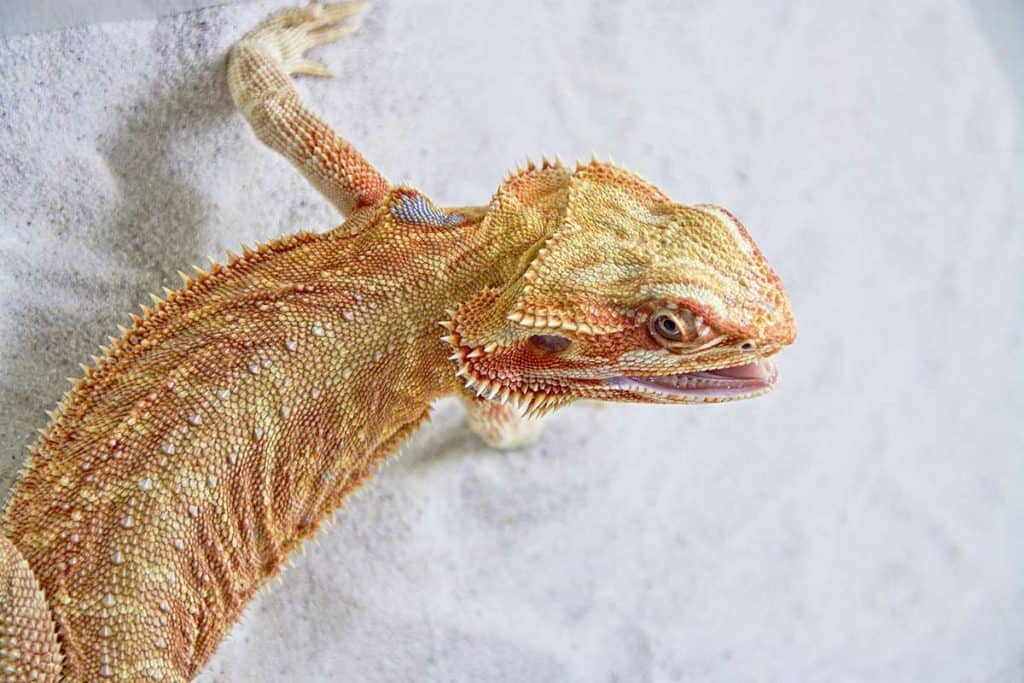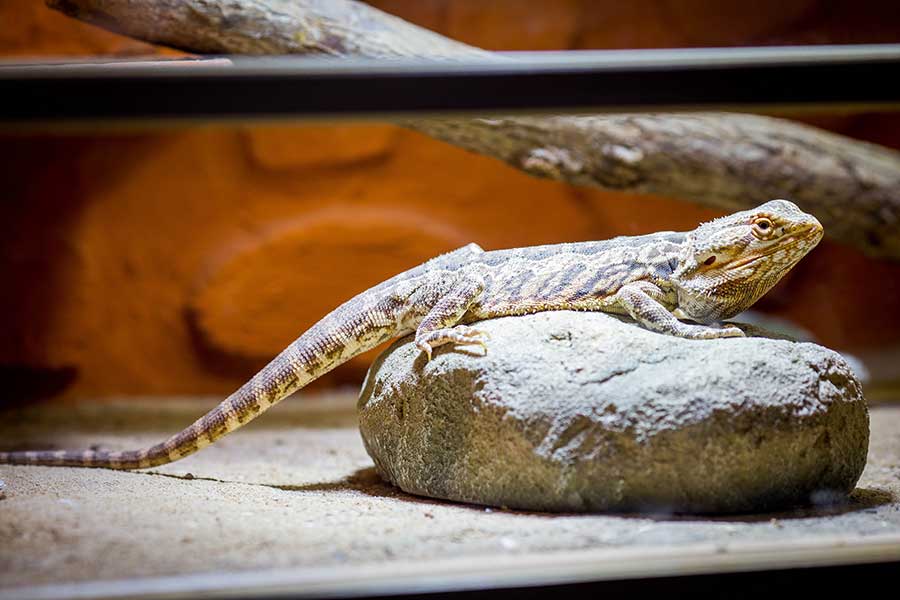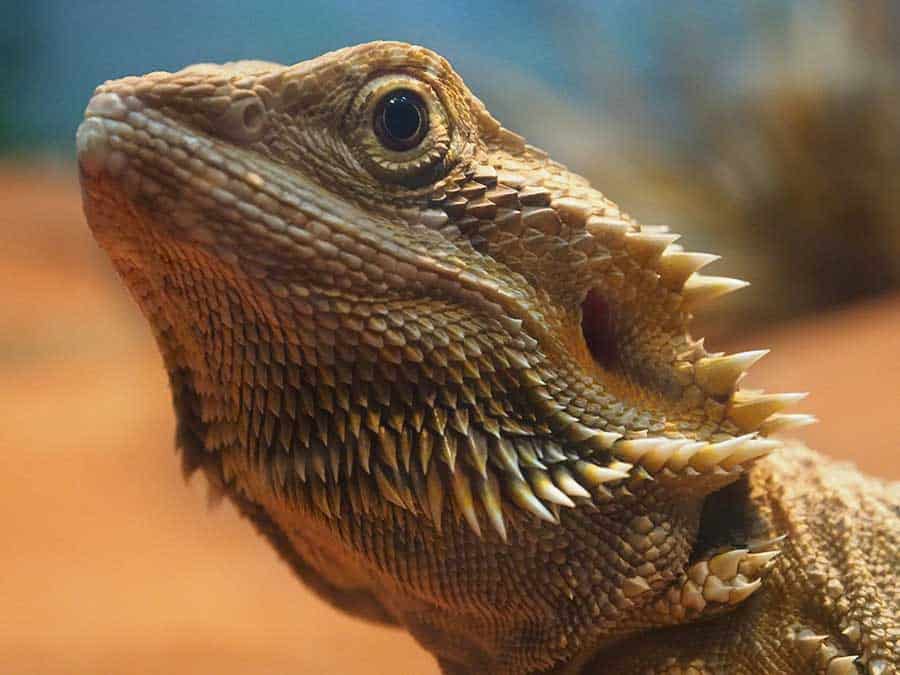As a bearded dragon owner, you might ask yourself: why do bearded dragons wave? It is a very cute behavior to watch. However, arm waving is usually considered a very human thing to do, and your beardie is definitely not a human.
Bearded dragons wave their arms as a form of communication. There are four reasons they wave their arms. The first and main reason for bearded dragon arm waving is to communicate submission. Bearded dragons need to show submission and dominance to other bearded dragons and animals. This is a consistent theme throughout the animal kingdom.
The second most common reason why beardies wave their arms is to show acknowledgement to the animals around them and let them know that they are aware of their presence.
The third reason is stress. It is important to know what stressful situations can cause bearded dragons to wave their arms and what you should do to avoid these situations.
The last reason beardies wave their arms is most definitely the cutest! They will often confuse their own reflections for another bearded dragon and wave in acknowledgment or submission.
If you want to know more about this strange and unique behavior, don’t worry; we’ve got you covered! We’ll also discuss certain stress-related issues that could cause your dragon to constantly wave their arms and what you can do to help your beardie with its nervous habit.
Reasons Why Bearded Dragons Wave
1. To Show Submission
Bearded dragons will often stabilize themselves on their back legs and one foreleg, raise their other foreleg, and wave it to the side. Most commonly, this is to signal to another bearded dragon that they are submissive and do not want any trouble.
Bearded dragons are very territorial animals, and arm waving is a way for submissive beardies to avoid physical confrontation with more dominant dragons. Even captive beardies will display this behavior. They will still wave to show their submissiveness even if they haven’t grown up in the wild.
Also, sometimes during mating and courtship behavior, a female will wave her foreleg to show she is submissive to a particular male and willing to mate with him. He will most likely be bobbing his head in return to indicate his interest in her. This is not the only mating behavior they will display, so keep a watchful eye out for other aggressive behaviors that may lead to a physical confrontation.
Young or sick bearded dragons will also wave in submission to older and stronger ones. It is a good idea to keep an eye on these displays of behavior to avoid any unnecessary confrontation.
As their owner, your bearded dragon may show this kind of submissive behavior to you, too! Your bearded dragon could be waving at you to let you know that it knows you are the boss.
2. To Express Fear and Stress
Bearded dragons also sometimes wave their arms to indicate their fear and stress. Frequent and rapid arm waving is a sign of great fear and stress. Here are some reasons why your beardie may be stressed or afraid and what you can do to help calm your beloved pet:
Unfamiliar Toys and Objects
If you have incorporated your beardie’s enclosure into the general household (instead of keeping it in a dedicated reptile room), then they get a good view of your world. A human’s world comes with things we do not think are fear inducing, such as televisions, pictures on walls, toy boxes, lamps, radios, and even candles. However, these objects can sometimes be unfamiliar and frightening to bearded dragons.
Bearded dragons may confuse children’s toys or objects such as clothing or decorations for other animals and see them as a threat. If these things are visible to your dragon for a long period of time, they will constantly be exposed to a high level of stress.
Put yourself in your beardie’s tiny little shoes and try to see what they see from the inside of their enclosure. Are there teddy bears, items of clothing, or pictures or paintings of people or animals around them that may cause them stress? Certain objects that emit loud sounds like TVs, radios, and alarm clocks can also stress them out.
Make any necessary adjustments to their surroundings to avoid causing them stress.
Unfamiliar Place
Moving for anyone is a stressful endeavor. Keep that in mind if you decide to move your bearded dragon’s enclosure to a different part of the house or to a different house altogether.
A new setting with new surroundings, sights, sounds, and smells may cause some level of stress in your beardie, which could result in nervous arm waving.
You should expect some arm waving and general nervousness from your beardie to happen during and right after a move. If the arm waving continues or increases after a week or two, then you should try to identify what else may be causing them stress or fear.
Strangers or Too Many People Walking Past
If your bearded dragon’s enclosure is in a very busy part of the house and they are constantly being confronted by large numbers of people walking past or around them, then they could be feeling very intimidated and upset.
This feeling will translate to anxiety and stress, which means they will arm wave rapidly and frequently. Try to avoid stressing your beardie out with overstimulation from too many people interacting with them.
Decorations within Their Enclosure
Getting a bearded dragon is very exciting, and you will want to make their enclosure as epic as possible. This is completely understandable, and you should make sure that your beardie has a comfortable and stimulating home.
However, sometimes a specific decoration in a bearded dragon’s enclosure will cause them stress. If you find that your beardie is hyper fixated on an object and constantly waving at it, then it probably sees it as a threat.
Remove the object, and monitor your dragon’s behavior to see if there is a change.
Enclosure Too Close to a Window
Putting your bearded dragon’s enclosure next to or near a window seems like a nice thing to do for them, as they will be able to see the outside world and watch many interesting things.
This can be great stimulation for them. However, it can also be like having a TV on all the time. Having that much stimulation can lead to raised anxiety and stress levels.
There may be things like cats and birds outside that sit near the window and are perceived threats. Your beardie may be waving in fear at the outside world.
If you notice your beardie is constantly waving at the window, try covering up that part of their enclosure or closing the curtain or blinds and see if there is a reduction in their fearful behavior.
3. To Acknowledge Others
Another reason why a bearded dragon may wave their arms is to simply indicate that they acknowledge the presence of another dragon, human, or some other animal. Here are some ways beardies wave their arms to address another animal’s presence:
Waving at You
Bearded dragons will wave their forelegs at an owner or other humans in their vicinity to let them know they have seen the person and are aware of their presence. This behavior is not necessarily to show submission or fear; usually, they are merely letting you know it has seen you and knows you’re there.
Provided they do not scurry away or start digging in the sand, this can be a good indication of when your bearded dragon is happy to be handled, as they are aware of your presence but not stressed or afraid.
It is not always easy to tell the difference between acknowledgement and fear, so it is better to stay on the safe side and avoid handling your beardie if it is waving a lot.
Waving at Other Dragons
Beardies may not be showing submission to other dragons when they arm wave. Sometimes, they wave their arms to let another dragon know they have seen them and don’t want any trouble.
Watch other nearby bearded dragons carefully for their behavioral signals and responses. If they also arm wave in response, then they are both probably just acknowledging each other’s presence. If the other dragon is bobbing its head or puffing out its beard, then it is displaying dominance.
Waving at Small Children and Other Pets
If you are not only a scaly parent but also a fluffy one and have other pets such as dogs and cats, then your bearded dragon will be aware of their presence in the household, too.
Bearded dragons may arm wave at pets the same way they do at humans or other dragons to let them know they have seen them and do not want any trouble.
It is always a good idea to make sure your pets and small children are secure with your bearded dragon. If they are calm and are not smacking, banging on, growling or yelling at, jumping up on, or clawing at your beardie’s enclosure, then your beardie should not see them as a threat and wave in distress.
If you have small children in the house, get them involved with your bearded dragon’s care so they understand and respect the animal. This will also help your beardie get used to them and not see them as a threat.
4. Befuddled by Their Reflection
We all love bearded dragons for how intelligent they can seem. Sometimes this intelligence gets put on hold when they confuse their own reflections for other bearded dragons.
Their enclosures are typically made of clear glass or plastic, so getting some kind of reflection is inevitable. Beardies will often arm wave and glass surf when they get confused by their reflections. This is usually not a cause for alarm, and it can be quite amusing to watch.
You can try altering their lighting or the lighting in the room around them to reduce the amount of reflection they see. It will also help to move any mirrors away from their enclosure.
Help! My Beardie Won’t Stop Waving!
If your bearded dragon is waving their arms constantly, they could be stressed because of something in or around their enclosure. Here are some things to look out for if your beardie won’t stop arm waving:
You May Have Habitat Problems
If your humidity and temperature gauges are old or faulty, any irregularities could cause environmental stress for your bearded dragon. Check your
It is also important to remember that you’ll need to purchase new UVB lights and replace them when they burn out, or around every six months.
Make sure your bearded dragon has a place to feel secure and destress after being presented with a stressful situation. The best way to do this is to include one or two hides, depending on the number of beardies you have in the enclosure.
Hides should be small, dark, dry places that feel safe to your bearded dragon. They should be big enough for the whole dragon to fit in but small enough that there isn’t a lot of extra space to overwhelm them when they are inside.
Your Beardie’s Enclosure Location Is Stressful
As we have previously discussed, too much activity around your bearded dragon’s enclosure will ramp up its anxiety and stress levels. Try moving the enclosure to a quieter part of your home if they are displaying constant arm waving at their surroundings outside of the tank.
You Have Too Many Bearded Dragons in a Single Enclosure
Bearded dragons are not ‘pack’ animals; they prefer to live alone. Having too many bearded dragons in the same tank can cause the less dominant ones to feel constant stress, which will result in constant arm waving.
Keep your beardies in separate enclosures and make sure they cannot see each other. If the rapid and constant arm waving stops, then you have solved the problem. If it does not stop, then look for a different source or stress.
Other Odd Bearded Dragon Behavior Decoded for You
In addition to arm waving, there are several other behaviors bearded dragons often use to communicate with each other and to other animals nearby. Here are a few to look out for:
Head Bobbing
Head bobbing might look very cool or cute, but in reality, it is a sign of dominance, aggression, or willingness to mate. Males tend to head bob during mating. They use the head bobs to signal to a female that they are interested.
Another reason why bearded dragons bob their heads is to communicate their dominance to other beardies in their enclosure.
If your beardie is frequently and rapidly head bobbing at you, then it could be a sign of aggression. You should not handle your dragon at this time, it will most likely result in a painful bite.
Beard Puffing
Both males and females puff up their beards for the same reasons dogs raise their hackles and cats puff out their fur: they want to appear bigger and more intimidating. If they are being threatened or are suddenly spooked, they may puff out their beards to look like big, scary dragons.
Additionally, they will occasionally just puff up their beard during a stretch.
Digging
Bearded dragons usually dig to find a more comfortable spot. If you notice your bearded dragon digging in a corner of their enclosure, they might be looking for a cooler or more secluded place to lay down.
Also, gravid female dragons will dig when they are preparing to lay their clutch of eggs. In the wild, bearded dragons typically bury their eggs in warm sand to incubate them; they will also attempt this behavior in captivity.
Make sure your beardie always has access to a hide and that their temperature and humidity settings are correct.
Darkening of Skin
Bearded dragons will darken their skin, particularly the skin on their beard, when they are agitated or feeling aggressive. If you are handling your beardie and notice their beard darkening, it is a good time to put them back to avoid being bitten.
If they are in an enclosure with other beardies and exhibit this behavior, then it is time to separate them.
Mouth Opening
More often than not, this is just a way for beardies to cool themselves off. You can learn more about why beardies open their mouths in this post.
FAQs About Bearded Dragon Arm Waving
Does arm-waving mean my bearded dragon likes me?
As cute as it might seem, bearded dragons do not wave at their owners to show affection. Bearded dragons will wave at owners in recognition or acknowledgment or to show their submission.
Is arm-waving considered a greeting for bearded dragons?
Humans greet each other by waving at each other, this is a very human concept. Bearded dragons are reptiles and do not wave to greet. Arm waving is used to signal submission, acknowledgment, fear, or confusion.
Do bearded dragons wave at people?
Yes, they do. Bearded dragons wave at people in acknowledgment, fear, or to show submission.
Is head bobbing the same as waving for bearded dragons?
Both head bobbing and arm waving are communication methods for bearded dragons. Arm waving is used to signal to others that a bearded dragon is being submissive, while head bobbing is a sign of dominance.
Do male and female bearded dragons wave their arms?
Yes, they do! It is more common for females to arm wave because they use it to signal to a male that they are willing to submit to mating. However, male bearded dragons will arm wave as well to show submission, acknowledgment, fear, or even confusion.
Should my bearded dragon wave?
Arm waving is not a requirement for bearded dragons. If you have a solitary bearded dragon and its enquire happens to be set up in the perfect way, then they will ot arm wave out of fear or stress.
My bearded dragon never waves; is this normal?
Your bearded dragon is probably the most relaxed and happy bearded dragon on the planet if it is not waving its arms at all, but this is normal, too. You could also simply be missing the occasional times that your beardie is waving its arms.
Waving Farewell to You!
Bearded dragons waving their arms looks very cute to humans because we consider waving to be a greeting or a friendly sign of communication. However, beardies are reptiles and play by different social rules.
Arm waving in bearded dragons is used to communicate to other animals around them. They may be communicating submissiveness or fear to any animal or bearded dragon around them. Alternatively, they may be communicating stress or anxiety, in which case you should check their enclosure settings and their surroundings for any potential triggers.
Your bearded dragon may simply be confused at their own reflection. Regardless of the reason, watching your bearded dragon and learning the meanings of their unique behaviors is key to keeping them happy and healthy!




